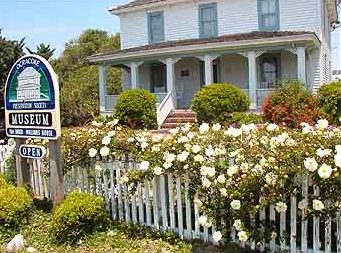One hundred and fifty years ago, the American Civil War made a brief but significant visit to the Outer Banks of North Carolina. Confederate forts were built on Hatteras and Ocracoke islands, but Union troops, eager to impose a blockade along the coast, attacked. By the end of 1861, both Confederate forts were defeated, and the islands remained in the hands of federal forces till the end of the war.
The Ocracoke Preservation Museum recently opened its doors for the 2011 season with a new exhibit depicting Civil War activity on Ocracoke and Hatteras. The exhibit, which is in keeping with the country’s focus on the sesquicentennial of the war, includes illustrations from 19th century editions of Harper’s Weekly and the Illustrated London Times. The illustrations depict Fort Ocracoke, the earthen, 20-gun fort built on Beacon Island and several views of the Battle at Hatteras. There is also an artifact, found near the fort in 1958, which has been identified as a bar or chain shot, used to disable sailing vessels.
It has been almost 30 years since a small group of Ocracoke residents with a vision of preserving Ocracoke’s heritage set out to make their vision of the museum a reality. They had noticed that the sleepy little fishing village was attracting more and more visitors, and, as a result, its character was changing. David and Sherrill Senseney, Phillip and Julie Howard, Linda Scarborough, and Anita Fletcher were among those who realized that unless caring people acted, Ocracoke would lose the character that made it unique.
They formed an organization which they called the Ocracoke Preservation Society (OPS) and set about creating a fine museum. Since then, OPS has expanded its original goals and supports many projects.
Today, OPS is a non-profit, community based organization with more than 450 members, including full and part-time residents, property owners, and visitors who love Ocracoke. It has a board of directors and a staff consisting of an administrator, DeAnna Locke, office manager Chrisi Gaskill, and a bookkeeper, Marcy Brenner.
The many volunteers who help staff the gift shop and participate in other activities are the backbone of the organization. The mission of OPS is to preserve the island’s cultural, historical, and environmental heritage. Based in a historic island home, it provides opportunities for residents and visitors alike to learn about the things that make Ocracoke special.
The Ocracoke Preservation Society Museum was originally the home of David Williams, the first captain of Ocracoke’s U.S. Coast Guard Station. The two-story, clapboard house, built around 1900, was a typical Ocracoke home.
OPS obtained the building in 1989 and moved it onto National Park Service property across from the Swan Quarter and Cedar Island ferry docks at the end of Highway 12. With donations of time, money, and family heirlooms, it was carefully restored.
The museum, which charges no admission, officially opened in 1992. It offers a view into island life at the turn of the last century, as well as exhibits on World War II submarine activities off the Outer Banks, the Ocracoke brogue, a seashell collection donated by Ruth Cochran, and Muse Bryant, Ocracoke’s beloved African-American centenarian.
Also housed in the building are a gift shop, the OPS offices, and a research library. Behind the museum is an exhibit which features a traditional 1936 Ocracoke fishing boat, the Blanche.
The gift shop focuses on items of local interest, such as island music, artwork, and books about Ocracoke. Other popular items include homemade island fig preserves, locally hand-made potholders, and Ocracoke’s traditional drink, yaupon tea.
The Ocracoke Preservation Society was instrumental in creating the Ocracoke Historic District. This irregular area surrounding Silver Lake Harbor, deemed a part of “the cultural heritage of our nation,” was entered into the National Register of Historic Places on Sept. 28, 1990. It consists of 232 contributing buildings, 15 contributing cemeteries, four contributing structures (the lighthouse, cisterns, picket fences, and docks), 139 non-contributing buildings, and one non-contributing structure. (Contributing buildings and structures are ones that were built before 1959 and have not had their integrity compromised by subsequent additions and changes.) Inclusion in the Historic District is not a mandate but a form of recognition.
In keeping with its commitment to support the Historic District, OPS recently purchased a 100-year-old island home so that it would be preserved. The house, located on Lighthouse Road, has been in the O’Neal, Styron, and Gaskins family for those years. The house is now for sale at $264,900 to someone interested in purchasing and restoring it. If interested, call 252-928-8029.
OPS also gives an annual Historic Preservation Award for restoration of an old island structure. Tom and Carol Pahl received this honor at the last membership meeting for their work on the Uriah and Maude Garrish house on Highway 12.
Two recent fundraisers were successful in raising money to support OPS. On April 1, storyteller and author Donald Davis entertained a good crowd with his stories and donated the proceeds – more than $5,300 — to the organization. On April 20, an auction at the museum, raised more than $2,100.
Other upcoming events include the OPS spring membership meeting. This semi-annual gathering will be on May 10, with a potluck dinner and “Stories of Ocracoke Island” by several storytellers.
Summer activities will include the always popular free OPS Porch Talks in June, July, and August, typically on Tuesday and Thursday mornings (best to check ahead, though, in case of schedule changes.) Children’s programs, which are funded by the Ocracoke Arts Council, will also be on the agenda.
If you plan a visit to Ocracoke Island, or live here now, make sure to put a visit to the Ocracoke Museum on your agenda and try to attend at least one of the special events.



